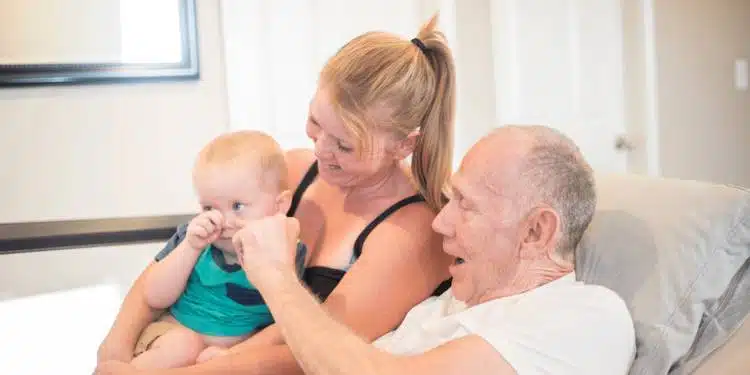By Rachel Bloom
Oh… That dreaded word…HOSPICE. That’s right – NO ONE wants to talk about it… But what if I say that it can also be called “comfort care” … then would you feel a little better?
My experience with hospice when my dad neared the end of his life was wonderful. These services allowed him to comfortably remain at home, surrounded by family and lots of love. People who provide hospice services do so with great compassion, making a difficult situation better for all involved.
Hospice is undoubtedly the best option in the last months of life. It offers a wide array of benefits for both the individual needing care and those left behind. Yet, despite the benefits, hospice remains a mystery to most Americans. Why is that? Is it because of society’s reluctance to discuss matters related to death?

7 Hospice Myths and Facts
Whatever the reason, people need to be educated about this tremendous resource and the services available, it’s important to separate hospice myths and facts.
You don’t need to wait until the end to begin hospice services.
You don’t have to be on death’s door to qualify for Hospice. In fact, you get the most benefit from hospice when you come on service early and develop a trusting relationship with your care team. The general guidelines say 6 months or less, but patients can be on service much longer, as long as they show signs of decline. You can qualify for hospice with a diagnosis of end-stage Dementia, COPD, Kidney Disease, Cancer, Heart Disease, Stroke, and other terminal illnesses. Unfortunately, the perception is that families bring in hospice only at the last minute.
Hospice does not speed up or slow down the disease process.
Contrary to popular opinion, hospice does not speed up the disease process or slow it down. Hospice simply provides comfort along the way. The team of professionals includes a nurse, nurse aide, social worker, and chaplain. You really get to know these special people and they become part of your village. My dad’s nurse, Missy, became a trusted friend, who reached out to us frequently to ask how things were going. She explained things clearly and told us what to expect. Alberto, the nurse aide, came on weekdays to bathe my dad and shave him so he always looked like himself.
Hospice saves you money.
Because most hospices accept Medicare, Medicaid, VA, and private insurance, the patient usually has no out-of-pocket costs! Hospice also pays for most medical equipment including a hospital bed, wheelchair, walker, and shower chair. In addition, they also cover supplies like diapers, wipes, and some medications. In my dad’s case, we were in desperate need of a hospital bed so we could raise and lower him with ease. When he came on service, the hospital bed was delivered immediately, along with a wheelchair and oxygen for emergency use. We also received his medications delivered to the house and lots of supplies!

Hospice can extend the life of a loved one.
Patients may actually live LONGER in hospice! A 2007 report by the National Hospice and Palliative Care Organization found that patients with certain terminal diagnoses who chose hospice lived an average of 29 days longer than similar patients who did not receive hospice services. Patients receive excellent and consistent care while they are in hospice. In addition, the communication between team members allows them to catch infections early, preventing additional health complications. For example, my dad developed a wound on his back. The nurse found it right away and began treating and assessing it during every visit. Another huge benefit is that they even provided wound care supplies!
You don’t “go to hospice”, hospice comes to you.
You can have Hospice services ANYWHERE and change your mind at ANY TIME. People often think that you have to “go to hospice.” In fact, hospice is a service that follows you! Whether you are at home, in an assisted living facility, or a nursing home, the team comes to your door and provides education, support, and updates to your family. If you decide that you don’t want to be in Hospice anymore (this is rarely the case!), you can change your mind at any time. Hospice even pays for respite care for 5 nights at any skilled nursing facility. If my mom ever felt like she needed a break, hospice would arrange transportation and make regular visits to my dad at his respite facility.
Hospice provides peace of mind.
When the time comes near, families are always grateful to have a peaceful end-of-life experience, as opposed to their loved ones being hooked up to all sorts of tubes and wires. The typical environment is usually very comfortable with families sharing stories and holding the hands of their loved ones. The hospice team is usually able to prepare these families, providing education and support along the way. For example, when my dad was declining, we could not move him from his hospital bed so I decided to bring our Friday night dinner to him! I put a table in his room and set up chairs so we could all sit comfortably. We told stories and sang songs. One of my most precious memories is that my dad was able to sing along with us and he felt so much love around him.
Hospice staff is available 24/7
The kind people who work for Hospice, aka the “Comfort Care Team” are on call 24/7…so that means if the patient isn’t feeling well or you have a question about the medication, you can call a nurse and she will visit if needed. Whether it’s at 3 a.m. on a Saturday or even Christmas, a Hospice nurse will be there for you! I must have called the on-call service so many times with medication questions and the need for a visit. When my dad began to transition, it was a weekend. of course! The nurse didn’t hesitate to come over and sit down with my mom and me, preparing us for his passing. She offered a continuous care nurse (hospice will pay for a nurse to stay with a patient and administer meds at the end of life if they meet Medicare requirements). My mom declined the continuous care nurse because wanted to take care of him on her own. To this day, she is glad she was able to spend that special time with him.
The Bottom Line
I truly hope that hospice won’t be such a scary word for you the next time you hear it. There are so many benefits to choosing comfort care at the end of life.
This holistic service is all about improving the experience for both the patient and the family. Each patient – and their situation – is unique, so the care plan provided is individualized. It’s a whole lifestyle of care with dedicated teams that include a doctor, nurses, social workers, pastoral counselors, home health aides, bereavement counselors, and other volunteers. If needed, they can even provide pet care. The goal is to take the burden of care off the caregivers so they can focus on their loved ones. And if you are one of the lucky ones who learned the benefits firsthand, help us educate others about hospice myths and facts.
I wasn’t able to change the outcome of my father’s disease, but I was sure able to give him lots of love and comfort during his last days.
FAQs About Hospice
Here are some commonly asked questions and answers to help you better understand hospice myths and facts.
What is the difference between hospice and palliative care?
These terms are often confused. Hospice care is like a warm embrace for those with serious illnesses who might not have much time left, usually around six months or less. It focuses on making them as comfortable and peaceful as possible during this time, without trying to cure the illness. Palliative care is like a helping hand that’s there for people with serious illnesses. It’s for anyone at any stage of their illness and aims to make them feel better by managing pain and symptoms. People can still get treatments that might cure them while receiving this care. So, palliative care can be given alongside treatments, while hospice care is for those nearing the end of life to make them as comfortable as can be.
Where is hospice care provided?
Hospice care can be provided in various settings, including the patient’s own home, nursing homes, hospice facilities, and hospitals. The goal is to provide care in the most comfortable and appropriate environment for the patient’s needs.
Who is eligible for hospice care?
Eligibility for hospice care typically requires a prognosis of six months or less to live, as determined by a physician. Patients with advanced or terminal illnesses, such as cancer, heart failure, or neurodegenerative diseases, may qualify for hospice care.
What services are included in hospice care?
Hospice care includes a range of services, such as pain and symptom management, emotional and psychological support, spiritual care, counseling for the patient and family, assistance with activities of daily living, and coordination of care among healthcare providers.
How is pain managed in hospice care?
Hospice care prioritizes effective pain management through medications and other interventions. A team of healthcare professionals works together to ensure the patient’s comfort and minimize pain and discomfort.
Is hospice only for the elderly?
No, hospice care is not limited to the elderly. People of all ages, including children, can receive hospice care if they have a terminal illness and meet the eligibility criteria.
Related Articles
Have You Had “The Conversation”?
Before It’s Too Late: How and Why to Talk to Your Aging Parents About Preplanning
25 FREE Resources for Caregivers and Their Loved Ones
About the Author – Rachel Bloom, LCSW
 Rachel Bloom, LCSW is a Community Liaison at Heart to Heart Hospice based in Plano, Texas. A caring and loving soul, Rachel is on a mission to educate the community to help them differentiate between hospice myths and facts. She strives to provide both patients and families with compassionate and helpful holistic hospice services and develop positive working relationships with healthcare professionals who deliver these services. Learn more about Heart to Heart Hospice Care on their Website or contact Rachel at rbloom@htohh.com or 214-850-4799.
Rachel Bloom, LCSW is a Community Liaison at Heart to Heart Hospice based in Plano, Texas. A caring and loving soul, Rachel is on a mission to educate the community to help them differentiate between hospice myths and facts. She strives to provide both patients and families with compassionate and helpful holistic hospice services and develop positive working relationships with healthcare professionals who deliver these services. Learn more about Heart to Heart Hospice Care on their Website or contact Rachel at rbloom@htohh.com or 214-850-4799.










